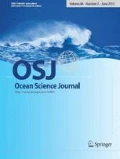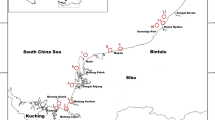Abstract
This study examined seasonal and annual occurrences of warm oceanic tintinnid species in southern Korea coastal waters. The indicative species of tintinnids was monitored using three approaches: monitoring from cruises traveling from the warm pool in the western North Pacific to the Korea Strait; biweekly or monthly monitoring in the Korea Strait; and daily monitoring in the nearshore water. Annual pulses of warm oceanic indicator species were regularly observed in the Korea Strait. In September 2008 recorded a maximum species number of warm water indicators, a representative species for warm oceanic waters, Climacocylis scalaroides was simultaneously detected in the nearshore water as well as the Korea Strait. The result indicates that the greater warm water extension into Korean coastal areas was in September 2008. Sharp declines in species diversity were observed in the transitional area between neritic and Kuroshio zone in East China Sea (ECS). Epiplocyloides reticulata, reported previously as a Kuroshio indicator, was considered an ECS indicator species, as it was undetected in the western North Pacific central zone but was found abundantly in the ECS. Tintinnid species can be used as biological indicators to detect the inflow of warm oceanic waters into Korean coastal waters.
Similar content being viewed by others
References
Alder VA (1999) Tintinnoinea. In: Boltovskoy D (ed) South Atlantic zooplankton. Backhuys Publishers, Leiden, Netherlands, pp 321–384
Balech E (1972) Los tintinnidos indicadores de afloramientos de aguas (Ciliata). Physis 31:519–528
Choi DH, Noh JH, Hahm MS, Lee CM (2011) Picocyanobacterial abundances and diversity in surface water of the northwestern Pacific Ocean. Ocean Sci J 46:265–271
Choi SH, Kim D, Kim KH, Min HS (2008) Spatial variability of surface fCO2 in the western north Pacific during summer 2007. Ocean and Polar Res 30:335–345
Dolan JR, Lemée R, Gasparrini S, Mousseau L, Heyndrickx C (2006) Probing diversity in the plankton: Using patterns in tintinnids (planktonic marine ciliates) to identify mechanisms. Hydrobiologia 555:143–157
Echols RJ, Fowler GA (1973) Agglutinated tintinnid loricae from some Recent and Late Pleistocene shelf sediments. Micropaleontology 19:431–442
Field DB, Baumgartner TR, Charles CD, Ferreira-Bartrina V, Ohman MD (2006) Planktonic foraminifera of the California Current reflect 20th-century warming. Science 311:63–66
Gómez F (2007) Trends on the distribution of ciliates in the open Pacific Ocean. Acta Oecologica 32:188–202
Hada Y (1937) The fauna of Akkeshi Bay, IV. The pelagic Ciliata. J Fac Sci Hokkaido Imp Univ Ser 4 Zool 5:143–216
Hada Y (1938) Studies on the Tintinnoinea from the western tropical Pacific. J Fac Sci Hokkaido Imp Univ Ser 6 Zool 6:87–190
Hada Y (1957) The Tintinnoinea, useful microplankton for judging oceanographical conditions. Inf Bull Planktol Japan 5:10–12
Hays GC, Richardson AJ, Robinson C (2005) Climate change and marine plankton. Trends Ecol Evol 20:337–344
Isobe A (1999) On the origin of the Tsushima Warm Current and its seasonality. Cont Shelf Res 19:117–133
Kato S, Taniguchi A (1993) Tintinnid ciliates as indicator species of different water masses in the western North Pacific Polar Front. Fish Oceanogr 2:166–174
Katoh O, Teshima K, Abe O, Fujita H, Miyaji K (1996) Process of the Tsushima Current formation revealed by ADCP measurements in summer. J Oceanogr 52:491–507
Kofoid CA, Campbell AS (1929) A conspectus of the marine and fresh-water ciliata belonging to the suborder tintinnoinea, with descriptions of new species principally from the Agassiz expedition to the eastern tropical Pacific 1904–1905. Univ Calif Pub Zool 34:1–403
Kofoid CA, Campbell AS (1939) The tintinnoinea of the eastern tropical Pacific. Bull Mus Comp Zool Harvard Coll 84:1–473
Lee CR, Choi KH, Kang HK, Yang EJ, Noh JH, Choi DH (2012) Biomass and trophic structure of the plankton community in subtropical and temperate waters of the northwestern Pacific Ocean. J Oceanogr 68:473–482
Lie HJ, Cho CH (2002) Recent advances in understanding the circulation and hydrography of the East China Sea. Fish Oceanogr 11:318–328
Lindley JA (1975) Continuous plankton records: a plankton atlas of the North Atlantic and North Sea: Suppl. 3-Tintinnida (Protozoa, Ciliophora) in 1965. Bull Mar Ecol 8:201–213
Middlebrook K, Emerson CW, Roff JC, Lynn DH (1987) Distribution and abundance of tintinnids in the Quoddy Region of the Bay of Fundy. Can J Zool 65:594–601
Min HS, Park JH, Choi AR, Park YG, Shin K, Jang PK (2011) Observation of water property variations in the western channel of the Korea Strait during 2006–2010. Ocean and Polar Res 33:325–336
Modigh M, Castaldo S, Saggiomo M, Santarpia I (2003) Distribution of tintinnid species from 42°N to 43°S through the Indian Ocean. Hydrobiologia 503:251–262
Pierce RW, Turner JT (1993) Global biogeography of marine tintinnids. Mar Ecol Prog Ser 94:11–26
Russell FA (1935) On the value of certain plankton animals as indicators of water movements in the English Channel and North Sea. J Mar Biol Assoc UK 20:309–332
Shon DH, Shin K, Jang PG., Kim YO, Chang M, Kim WS (2008) Effect of thermal stratification and mixing on phytoplankton community structure in the western channel of the Korea Strait. Ocean and Polar Res 30:261–275
Takikawa T, Yoon JH, Cho KD (2005) The Tsushima Warm Current through Tsushima Straits estimated from ferryboat ADCP data. J Phys Oceanogr 35:1154–1168
Taniguchi A (1978) Reproduction and life histories of tintinnid ciliates (Review). Bull Plankton Soc Japan 25:123–134
Taniguchi A (1983) Microzooplankton distribution along a transverse section crossing a marked oceanic front. La mer 21:95–101
Thompson GA (2004) Tintinnid diversity trends in the southwestern Atlantic Ocean (29 to 60°S). Aquat Microb Ecol 35:93–103
Zeitzschel B (1969) Tintinnen des westlichen Arabischen Meeres, ihre Bedeutung als Indikatoren für Wasserkörper und Glied der Nahrungskette. Forsch Ergebn’ Meteor’ (Reihe D) 4:47–101
Yoo SH, Yoon JH (2008) Seasonal volume transport variation and origin of the Tsushima Warm Current. Ocean and Polar Res 30:193–205
Author information
Authors and Affiliations
Corresponding author
Rights and permissions
About this article
Cite this article
Kim, YO., Shin, K., Jang, PG. et al. Tintinnid species as biological indicators for monitoring intrusion of the warm oceanic waters into Korean coastal waters. Ocean Sci. J. 47, 161–172 (2012). https://doi.org/10.1007/s12601-012-0016-4
Received:
Revised:
Accepted:
Published:
Issue Date:
DOI: https://doi.org/10.1007/s12601-012-0016-4



